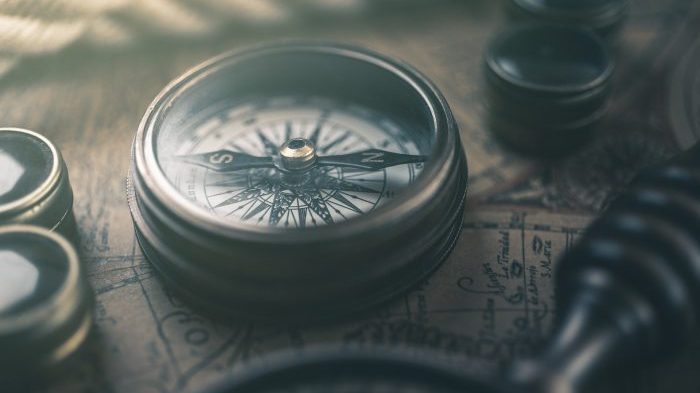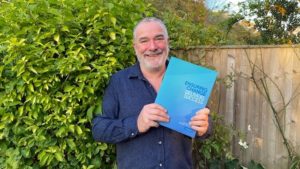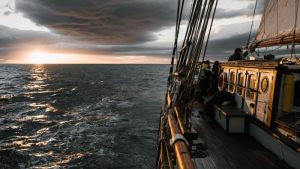Following on from last weeks article…
As a former Commercial Passenger Ferry Skipper, I regard the compass as an essential piece of kit.
Actually… it is more than that. It is a companion and familiar ‘friend’ that I use continually when in the field or on the ocean. I have been trained and assessed in its use, allowing me to take passengers to sea, but it’s an instrument that takes time to master. Understanding what it does is straight forward…
1. It helps to orientate people and charts
2. It allows us to figure out where we are
3. It helps us choose the direction of the next stage of the journey…
Using it skilfully though, is a whole new question and takes much practice.
As a businessman I have also developed my own ‘inner compass’ for personal and organisational use. This does the same job as my field or ships’ compass.
In fact, I use two such compasses. The first one is inward facing and has Cardinal points starting with Spiritual Intelligence, (SQ and Magnetic North) Business Intelligence, Political Intelligence and Emotional Intelligence. This helps me orientate myself in the buffeting of life. My second compass has an outward perspective and has Justice as the North Cardinal Point with the southerly one being Compassion. East is about Community and west is about Meritocracy. This combined framework informs all my choices. Your compass(es) I am sure will be different, but the important thing is that you are intimate with what you have developed. One of my SQ components of this inner compass, is about listening to that small voice that has guided me over many decades.
A few weeks ago, this saved my life… literally.
I had a heart attack in a remote location, although not too far from home. In the 5 minutes before becoming unconscious and in excruciating pain, I had to decide who to contact. My decision was counter logic, because the ‘wee voice’, call it intuition or a heavenly nudge, said ‘call your daughter’ and not 999. Sarah arrived in just 5 minutes and then called for an ambulance. She was put on hold for 15 minutes. Eventually she was connected and gave instructions on where they would find us and what track to take. They arrived quickly and did a brilliant job to stabilise me and prep me for an immediate operation. So, thank you wonderful NHS! The point being, that if I had rung 999, I would have been unconscious before they got back to me on the phone, and I would have died alone. So, my inner compass is critical to me and has been over the years because it informs a continual series of ‘choices’ about direction and speed of response. This in turn enables me to navigate across a particular territory.
Territories will either be.
· Known and familiar
· Less frequented, and therefore unfamiliar
· Unknown to me, or perhaps anyone else!
And the continual set of choices and decisions will be a mixture of ‘Puzzles’, which are describable and have a limited number of solutions… (provided you have most of the information), through to what Meryn King and John Kay describe in their excellent book as, issues of ‘Radical Uncertainty’. The latter represent the ‘unknown, unknowns’ popularised some years ago by Donald Rumsfeld and parodied ever since! These require a whole new approach that many just aren’t trained for.
With multiple tsunamis from Climate Change to Covid and from Digital Transformation to Brexit, it is clear we are being forced to navigate the ‘uncharted waters’ described by Klaus Schwab of the World Economic Forum, much more often. We may not have the charts but we each potentially, have a ‘compass’. This was true also, for early Explorers and Pioneers. However, the compass has some quirks and features which aren’t explored in the organisational press and on social media, that need to be considered and understood, as any experienced navigator would know.
Simply put… compasses have ERROR and BIAS from 2 main sources. This is amplified by unskilled usage. Variation and Deviation are inevitable, but can be offset, with skill and training.
Summary of ‘Variation’.
A compass needle points to Magnetic North, whereas maps and charts are orientated towards True North. These two locations are different, and this difference is called ‘Variation’.
In the earth’s core there is a huge magnetic mass which pulls every magnetised compass needle toward it. This mass is also moving around so its actual position varies. What this means is that the:
… difference between True North and Magnetic North, also varies, according to where you are in the world. This difference can be calculated based on known and yet shifting data.
The shift in the magnetic core is known and precise figures are available through many sources. What this all means to navigators, is that I must translate magnetic data into the information on the chart. So, if I take a compass reading and want to draw a line on the chart indicating my proposed direction, I must
1. Use up to date information,
2. Apply the correct formula
3. Do some Math.
This also applies if I am translating information from the chart, into magnetic bearings which are then used to steer my vessel.
In business terms this is the equivalent activity of translating information displayed on charts and maps into real life. Now skilled analysts will have collected the data carefully from people involved in the various processes and this will have been built together into accurate representations of how the system works. However even the best maps are just ‘representative’ of how things are, just as algorithms are based on a set of assumptions which may or may not be true. So, the ability to translate is critical.
This also means that our internal ‘maps of the world’ which help us to make sense of things, also need to be translated. How we think things are and how they really operate, may not be the same. And then this gets further complicated because often we are dealing with people’s perceptions of reality, rather than facts. So, at the simplest level this one factor of variation, should remind us to look behind presented material, understanding the complexity and range of perspectives, as opposed to how they might be drawn up on some business map or plan. Also, with so many personal ‘compasses’ with differing cardinal points informing choices, (plus organisational protocols in place) we must understand and align these decision-making processes before we need to make decisions.
Summary of ‘Deviation’.
Deviation or ‘bias’ is where the compass has been contaminated by outside magnetic sources which influence where the needle points to. So Magnetic North can be either side of the North pointing needle.
Again, the issue is … when let’s say you are navigating a very tight situation requiring real precision, any error might prove critical and indeed disastrous. Deviation is also amplified over distance. One degree of error at the start, having travelled 60 miles will put you one mile away, from the intended destination.
For this reason, every navigator is required to know, the extent of the error so that it can be corrected when translating information off or onto charts. As a Captain I am required each yearto find out the extent of this error by comparing my compass readings with a moderated set of figures. This activity is called ‘Swinging the Compass’.
In life too it is wise to regularly check to see if our compass is up to date and functioning accurately. So, this maybe is about spending time with people who have a different view of the world or emphasis, or reading material that may challenge our beliefs and values… or indeed spending time in another culture… With this activity of metaphorically ‘swinging the compass’, you are trying to surface small errors which could have massive impact over time. You will probably not discover, that South is the new North… unless of course there is a reversal of the poles, which has happened… and possibly will happen again the future!
So, taking account of both Variation and Deviation, decisions are informed and then taken with ‘courses laid in’. The compass therefore must be used intelligently to help figure out direction. Those with less experience simply regard the cardinal points of the compass as pure sources of guiding information. Popular at present, is the assertion that Emotional Intelligence is the the compass! It may be the North cardinal point of your compass but what about South, East and West? Sometimes True and Magnetic North are used interchangeably. In the real world it doesn’t work like that.
Leaders do need to understand the detail, and this continually changes. Navigation demands a continual reading of the situation, interpreting the systemic data and extrapolating the options which define choices. So, leaders need to have this all at hand. And, even in calm conditions things can change in an instant. At these times, having the information accessible in a form that is immediately informative and intelligent is just so critical. Scrambling around for the information in an ‘event’ or emergency, is not a pretty sight! In fact, most disasters at sea occur through an escalation of poor responses, triggered by something that started as a small issue of detail.
In the next 2 articles I will translate all of this into the world of business and organisations by answering the question… ‘so what does this all mean?’
Two Questions
- What strategies do you use to translate various organisational maps into real life using your own compass?
- How do you make sure your bias and error are known and taken into account when making decisions?
Links to the series of articles:



